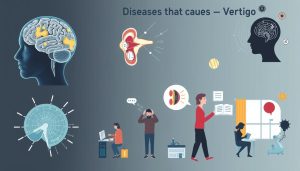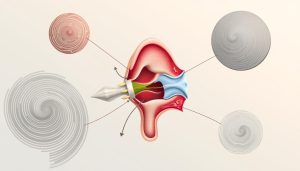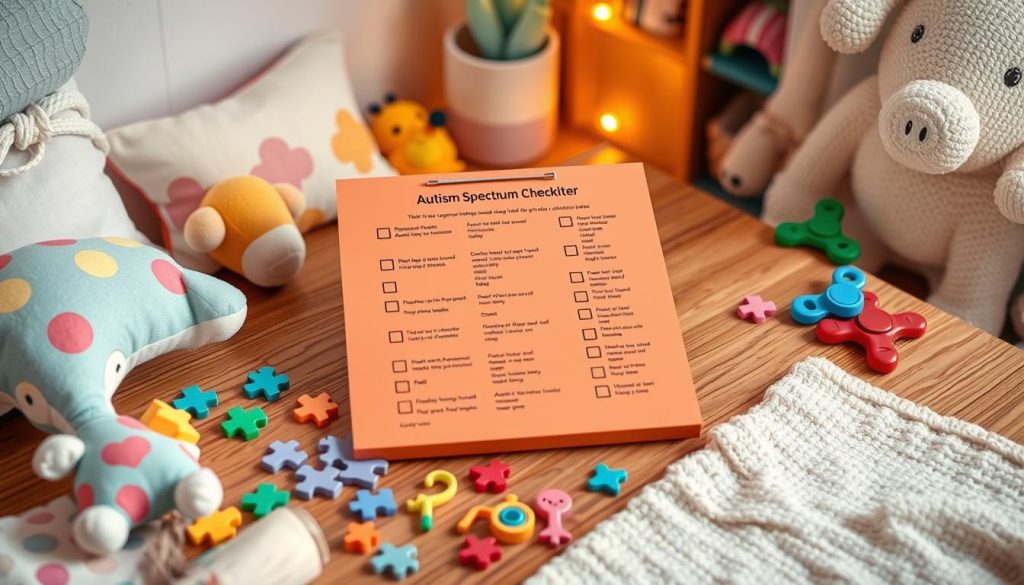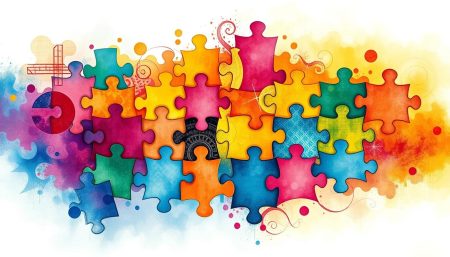Understanding Autism Spectrum Disorder (ASD) is complex, but key for caregivers and health professionals. They are vital in spotting ASD symptoms early. A detailed autism spectrum disorder checklist is essential for this task. It helps identify early signs and leads to a correct diagnosis.
An effective checklist captures the wide range of ASD signs. It helps spot unique behaviors and developmental signs that might point to ASD. Its main goal is to start timely help, which greatly improves outcomes for those with ASD. It encourages families to get professional help and tailored care plans.
An autism diagnosis checklist goes beyond just tracking development. It lists specific signs to help those who first notice ASD. This checklist gives a clear way to find autism, making it easier to understand and identify.
Understanding Autism Spectrum Disorder (ASD)
Autism Spectrum Disorder (ASD) is a complex neurodevelopmental condition. It affects social interaction, interests, and behaviors. Each person with ASD is different, so a tailored approach is key for support.
Defining ASD: Core Characteristics and Variability
ASD has unique core characteristics for each person. Spotting these signs early is vital. A reliable ASD symptoms checklist helps identify these traits in various settings.
Common signs include trouble with social communication, sensory sensitivities, and a need for routine. These can affect daily life.
The Importance of Early Identification and Intervention
Spotting ASD early is critical for better outcomes. Tailored interventions can improve communication and social skills. A developmental checklist for autism helps track progress.
| Age | Expected Milestone | ASD Red Flags |
|---|---|---|
| 12 Months | Responding to name | Lack of response to name |
| 18 Months | Pointing to show interest | No pointing or gesturing |
| 24 Months | Two-word phrases | Lack of combining words |
This table shows how milestones guide early ASD detection. Regular check-ups with a detailed checklist help caregivers and professionals act early. This can change a child’s development path for the better.
Components of a Reliable Autism Spectrum Disorder Checklist
Creating a good autism checklist needs several key parts. These parts make the checklist accurate and useful. They help spot Autism Spectrum Disorder (ASD) early, which is key for treatment.
Communication skills and social interactions are at the heart of many ASD tests. Watching how a child talks and acts with others shows if they might have ASD.
- Autism Behavior Checklist: This list checks for things like eye contact, hearing their name, and wanting to play with others. It’s made to catch small details in everyday life.
- Observational Assessments: These happen in real-life settings. They’re a big part of checking for autism.
Behavior patterns are also very important. They’re listed in the checklist to show different behaviors. This includes repeating actions, not wanting to change, or being very interested in certain things.
To make sure these parts work well together, updates are needed. They should come from the latest research and feedback from doctors.
Autism Spectrum Disorder Checklist
Monitoring children for Autism Spectrum Disorder (ASD) needs detailed checklists. These highlight important milestones and behaviors. We focus on communication, language, and social skills that might show ASD.
Communication and Language Development Milestones
Early signs of autism often show in language and communication. Caregivers might notice delays or unusual skills. Key signs include:
- Little to no babbling by 12 months
- Lack of gesturing (pointing, waving goodbye) by 12 months
- Delayed first words beyond 16 months
- Does not combine two words by 24 months
- Regresses in language or social skills at any age
Social Interaction and Behavioral Markers
The checklist also looks at social interactions and behaviors. These signs help spot ASD early. Important signs include:
- Poor eye contact
- Lack of interest in peer relationships
- Difficulty understanding and expressing emotions
- Engagement in repetitive movements (e.g., rocking, flapping)
- Insistence on sameness and routine
| Age | Communication Milestones | Behavioral Milestones |
|---|---|---|
| 12 Months | No babbling or pointing | Limited eye contact |
| 24 Months | Does not use two-word phrases | Shows intense need for routines |
| 36+ Months | Poor conversational abilities | Persistent repetition in play |
An autism evaluation checklist helps caregivers and professionals track a child’s growth. It’s key for spotting autism early and starting help right away.
The Role of Screening Tools in Diagnosing Autism
The journey to diagnose Autism Spectrum Disorder (ASD) begins with screening tools. These tools are key for spotting early signs of ASD. They help identify those who need a deeper look through detailed tests.
Screening tools don’t give a final diagnosis. But, they mark the first step to find out if someone might have ASD. They help spot early signs and send people for more tests.
The Difference Between Screening and Diagnosis
Screening for autism, like using a checklist, doesn’t confirm a diagnosis. It’s a first step to show if more tests are needed. Healthcare experts then do further checks.
Commonly Used Autism Screening Checklists
Many tools are used to spot early signs of ASD. The Modified Checklist for Autism in Toddlers (M-CHAT) is for kids as young as 16 months. It checks for ASD risks. The Autism Diagnostic Observation Schedule (ADOS) is used for different ages. It helps by watching how people act.
Every tool, from checklists to detailed schedules, is important for diagnosing autism. For more on diagnosing substance-related disorders, learn about signs and criteria.
Early Signs of Autism Checklist for Toddlers
Spotting early signs of autism in toddlers is key for early help. The early signs of autism checklist helps parents and caregivers spot the first signs of autism in young kids.
The autism behavior checklist points out certain behaviors that show a child might have autism. Along with the developmental checklist for autism, these tools help figure out if a child’s behavior is normal or if it’s a sign of autism.

- Limited use of gestures such as pointing or waving
- Delayed speech and language skills
- Lack of interest in playing with other children
- Persistent preference for solitude
- Repetitive behaviors such as flapping hands, rocking, or spinning
- Unusual responses to sensory experiences
- Difficulty adapting to new routines or changes in environment
Spotting these signs early with the early signs of autism checklist can lead to quicker diagnosis and help. Knowing the autism behavior checklist and developmental checklist for autism helps parents and caregivers get help fast.
Developmental Checklist for Autism in Preschoolers
It’s important for caregivers and teachers to use a special checklist for autism in young children. This tool helps spot signs that might mean a child needs a closer look. It’s all about catching early signs for better help.
Identifying Atypical Development in Play and Learning
Children with ASD often act differently in play and learning. An ASD symptoms checklist can help spot these signs. It’s about noticing small things that might mean a lot.
- Limited pretend play
- Difficulty in making friends or interacting with peers
- Persistent fixation on parts of objects
Critical Developmental Milestones to Monitor
Watching for developmental milestones is key to spotting autism. Here’s a table with important signs for young kids. It’s a guide to check against an autism assessment checklist.
| Age | Developmental Milestones | Indicators of Possible Concern |
|---|---|---|
| 2 Years | Speaks in two-word phrases | Frequent echo of phrases instead of spontaneous language |
| 3 Years | Can follow multi-step instructions | Difficulty following simple instructions |
| 4 Years | Understands the concept of same/different | Struggles to compare basic categories or concepts |
Using a detailed developmental checklist for autism in preschoolers helps find problems early. It also helps teachers and families support kids better. It’s all about meeting each child’s unique needs.
Signs of Autism in School-Aged Children
Recognizing autism in school kids is vital for early help. We need to adjust the autism checklist for older kids. This helps us see how they do in school and with friends.
Adapting the Checklist for Older Children
As kids get older, their needs change. The checklist for them must reflect this. It looks at things like making friends, understanding groups, and getting social cues right.
Assessing Social Skills and Academic Challenges
Seeing how kids do in school can tell us a lot. Trouble with abstract ideas, issues in group projects, or odd reactions to classroom sounds are clues. Looking at both social and school skills helps us support them better.
| Age Group | Social Interaction Milestones | Academic Interaction Markers |
|---|---|---|
| 6-8 Years | Understands rules of simple games, beginning to show empathy | Struggles or excels in learning basic math and reading skills |
| 9-12 Years | Develops more complex friendships, understands others’ perspectives | Shows interest or significant challenge in detailed academic subjects like science and history |
Autism Diagnosis Checklist for Health Professionals
When doing a health professional autism assessment, a autism diagnosis checklist is key. It helps doctors spot and record important signs and milestones. These are vital for a correct diagnosis.
Here are the main parts of a good autism screening checklist for health pros:
- Look closely at how the child talks and communicates without words.
- Check how they act around others, like responding to friends and playing together.
- See if they have any habits or interests that they keep coming back to.
- Watch for any special sensitivities to sounds or touch.
- Look at their past to see if they’ve had any delays or steps backward in growing up.
This detailed method helps doctors give a thorough health professional autism assessment. It leads to better help and support for the child.
| Area of Assessment | Details to Observe |
|---|---|
| Communication | Check for delays in speech, difficulty in initiating or sustaining conversation. |
| Social Interaction | Observe the ability to form friendships, response to social interactions and emotional reciprocity. |
| Behavioral Patterns | Identify any repetitive movements, rigid routines, or resistance to change in routine. |
In short, the autism screening checklist is a vital tool for health pros. It’s used to make accurate diagnoses and plan effective treatments.
Parent-Led Autism Behavior Checklist: A Tool for Home Observation
Parents play a key role in tracking their child’s growth. The autism behavior checklist is a vital tool for families. It’s made for home use, helping parents add valuable insights to their child’s records.
Creating a Conducive Environment for Monitoring
Creating a good space for observation at home is important. It should be quiet and free from distractions. This setup helps parents accurately track their child’s behavior and social skills.
Behaviors to Observe and Record at Home
Here are some behaviors parents should watch for:
- Response to their name or other verbal cues
- Eye contact during communication
- Initiation of and response to social gestures
- Frequent echolalia or repetitive language use
- Patterns in play, including repetitive or restricted ones
Recording these behaviors helps track progress and spot areas needing expert help.
Using this checklist daily helps parents understand their child better. It supports in diagnosing autism and helps manage it. Regular use makes parents more proactive in their child’s care.
Integrating Autism Assessment Checklist with Other Diagnostic Measures
Using just an autism assessment checklist might not fully understand a child’s needs. This is why a multidisciplinary diagnostic approach is key. It combines different tools and expert opinions for a complete picture of a child’s abilities and challenges.
The Importance of a Multidisciplinary Approach
A team of healthcare experts, like doctors, psychologists, and speech therapists, work together. They use the checklist and their own findings to get a clear picture. This teamwork helps in making a precise diagnosis and creating a plan that fits the child’s needs.
When to Seek a Specialist’s Insight
It’s important to see a specialist for ASD if the checklist shows complex issues. Specialists have more advanced tools and insights. They help parents and teachers find the right support and strategies for the child.
| Assessment Tool | Purpose | Specialist Involved |
|---|---|---|
| Autism Assessment Checklist | Initial screening for ASD markers | Pediatrician |
| Cognitive Assessments | Evaluating intellectual abilities | Psychologist |
| Speech and Language Evaluation | Assessing communication skills and challenges | Speech Therapist |
| Behavioral Assessment | Observing and interpreting behavior in different settings | Behavioral Analyst |
| Neurological Testing | Identifying neurological issues contributing to ASD symptoms | Neurologist |
Using the Autism Evaluation Checklist During Clinical Visits
During clinical ASD assessment visits, the autism evaluation checklist is a key tool for health professionals. It helps ensure a thorough evaluation of behaviors, communication, and social interactions related to autism spectrum disorders (ASD).
The checklist helps identify symptoms that match ASD criteria. Health professional autism assessment practices use this checklist to start the diagnosis and treatment planning process. Here’s a closer look at the checklist’s components used during clinical visits.
- Behavioral interactions
- Communication abilities
- Social engagement
- Sensory sensitivities
- Developmental history
Parents and caregivers should prepare for the evaluation by observing and noting any unusual behavior in their child. This information helps clinicians use the autism evaluation checklist more accurately.
| Component | Description | Impact on Diagnosis |
|---|---|---|
| Behavioral Observations | Assessment of both verbal and non-verbal behaviors. | Helps identify patterns that are indicators of ASD. |
| Communication Skills | Evaluation of both expressive and receptive language abilities. | Essential for diagnosing communication delays associated with ASD. |
| Social Interactions | Observation of interactions with peers and adults in various settings. | Crucial for understanding social engagement levels and challenges. |
| Sensory Processing | Analysis of responses to sensory stimuli. | Provides insight into sensory sensitivities or preferences specific to ASD. |
| Historical Information | Review of developmental milestones and medical history. | Supports a complete view of the child’s health and development. |
This table shows the main parts of the autism evaluation checklist during clinical visits. It highlights the key areas for a detailed clinical ASD assessment. Parents can expect a thorough review of these components during the assessment. They are encouraged to share any additional insights and observations.
The autism evaluation checklist helps professionals provide more tailored and effective diagnoses. It also sets the stage for targeted interventions that meet each child’s unique needs.
Technology’s Role in Enhancing Autism Checklists
Technology has changed how we use autism spectrum disorder checklists. With digital tools for autism, doctors and caregivers can track progress better. This helps make care plans more accurate and timely.
Digital Tools for Tracking Developmental Progress
Apps for tracking developmental progress are key in managing autism. They help monitor behaviors and milestones in real-time. This is vital for creating personalized treatment plans. These tools also help teams work together, supporting individuals with autism better.
Improving Accuracy Through Apps and Software
Getting accurate data on development is critical for autism management. Modern apps and software use advanced methods to reduce errors. They give a detailed view of an individual’s growth and challenges. These tools are essential for improving the autism spectrum disorder checklist.
Collaborating with Educators: An Autism Checklist for Teachers
Working together, educators and specialists play a big role in helping students with Autism Spectrum Disorder (ASD). The autism checklist for teachers is a key tool. It helps teachers see how to better support students with autism. This checklist makes classrooms more inclusive and helps all students learn better.
Classroom Observations and Interactions
Watching how students act and interact in class is very important. The checklist helps teachers notice and understand these behaviors. It guides them in changing how they teach to meet each student’s needs.
By watching students closely, teachers can find out what works best for them. This helps in making learning plans that really help students with autism.
Building an Inclusive Learning Environment
A classroom that welcomes everyone is good for all students, not just those with ASD. Teachers use the checklist to make sure their classrooms are welcoming. They use things like structured lessons and sensory-friendly spaces to help all students feel included.
Creating a place where everyone can learn and grow is key. Teachers use the checklist to make sure their classrooms are places where everyone can succeed.
| Checklist Item | Purpose | Implementation Strategy |
|---|---|---|
| Structured routines | Reduce anxiety and confusion | Consistent schedule with clear visuals |
| Sensory accommodations | Enhance comfort and focus | Use of noise-canceling headphones and sensory toys |
| Peer interaction facilitation | Promote social skills | Structured group activities and buddy systems |
| Visual aids for instruction | Improve comprehension | Pictorial or video instructions |
| Feedback methods | Encourage communication and adjustment | Positive reinforcement and clear, concise feedback |
Teachers use these tools and strategies to help students with ASD learn. They also make the classroom a better place for all students. This way, schools become places where everyone can learn and grow together.
Legal and Ethical Considerations in Autism Spectrum Assessments
When doing Autism Spectrum Disorder (ASD) assessments, experts must follow strict ethical considerations in ASD assessments and make sure they follow legal compliance in autism diagnosis. These rules help protect the rights and dignity of those being tested. They also make sure the diagnosis process is fair and accurate.
Keeping information private is key in ASD assessments. Doctors must handle personal data carefully. They can only share it with people who are allowed to see it or with the person’s permission. This shows they follow HIPAA rules and other health data laws.
ASD tests must be fair and unbiased. Doctors need to keep learning about new ways to diagnose. This helps them make accurate and fair diagnoses. Laws in different places can change, so it’s important for doctors to know what’s expected of them.
Here’s a look at how different places handle privacy and accuracy in ASD tests:
| Region | Privacy Regulations | Diagnostic Standards |
|---|---|---|
| United States | HIPAA compliant, strict data protection | Follows DSM-5 & IDEA |
| European Union | GDPR compliant, strong data protection | Uses ICD-10, needs detailed records |
| Canada | PIPEDA act protects personal info | Follows DSM-5, wants clear diagnosis process |
In short, ethical considerations in ASD assessments and legal compliance in autism diagnosis are more than rules. They are essential for a fair, private, and unbiased test. Following these guidelines builds trust and makes the diagnosis more effective and accepted.
Resources and Support for Families Using the ASD Checklist
Starting with an autism spectrum disorder checklist can be a big step. Finding a supportive network is key. Families can find help through support groups and financial aid for ASD care.
Connecting with Local Autism Support Groups
Support groups for autism offer a community that gets it. They share experiences, advice, and encouragement. Families can find these groups at health centers, schools, and autism-focused non-profits.
- Monthly meetings
- Parent-led workshops
- Social events for family bonding
Navigating Insurance and Financial Assistance for ASD Care
Understanding financial help for ASD care is vital. Insurance may cover some costs, but not all. Families can get help from advocates and advisors who know ASD care well.
- Exploring government-funded programs
- Qualifying for grants and scholarships for ASD therapies
- Using tax-advantaged savings for medical costs

Advancements in Autism Research and Future Checklist Development
The world of autism spectrum disorder (ASD) is always changing. New autism research advancements are helping us understand and treat it better. As we move forward, we expect ASD checklists to get more accurate and personal for each person.
Recent studies have used many methods, like genetic analysis and brain scans. These studies give us deep insights into ASD’s causes. They help us improve how we diagnose and treat it. Also, new tech like data analytics and machine learning might make diagnosing ASD faster and more accurate.
Research is moving towards a deeper understanding of ASD’s many forms. As scientists learn more, ASD checklists will become more detailed and personal. This progress means we can offer better care to each person with ASD, tailored just for them.
FAQ
Q: What is an Autism Spectrum Disorder Checklist?
A: An Autism Spectrum Disorder Checklist helps spot early signs of Autism Spectrum Disorder (ASD). It guides caregivers and health professionals to see if a diagnosis and help are needed.
Q: Why is early identification and intervention important for ASD?
A: Finding and helping with ASD early can really help. It lets support start early, which can improve learning, talking, and social skills.
Q: What are the core characteristics of Autism Spectrum Disorder?
A: Autism Spectrum Disorder includes trouble with social talking and acting, and repeating certain behaviors. Each person with ASD has their own mix and level of symptoms.
Q: How does an autism assessment checklist differ from an autism screening checklist?
A: An autism assessment checklist is for health pros to check detailed criteria. An autism screening checklist is for caregivers and teachers to spot kids who might need a deeper look.
Q: What milestones are included in an early signs of autism checklist for toddlers?
A: For toddlers, the checklist looks at social skills, talking, and behavior. It checks for things like responding to their name and playing with toys in a special way.
Q: What should parents look for in a developmental checklist for autism in preschoolers?
A: Parents should watch for signs in social skills, talking, play, and learning. Look for behaviors that might show ASD.
Q: Can the autism spectrum disorder checklist be adapted for school-aged children?
A: Yes, the checklist can be changed for school kids. It looks at social and school challenges, and how they talk and act with others.
Q: How should parents use a parent-led autism behavior checklist at home?
A: Parents should watch and note behaviors at home. This helps spot signs of ASD to talk about with doctors.
Q: What is a multidisciplinary approach in ASD diagnosis and why is it important?
A: A team of doctors, like pediatricians and psychologists, work together for a full check. This is key to really understand a person’s abilities and challenges.
Q: What digital tools can enhance the effectiveness of autism checklists?
A: Digital tools, like apps, help track progress and improve symptom tracking. They make it easier for caregivers and doctors to share information.
Q: Why is collaboration with educators important when monitoring for ASD in a school setting?
A: Teachers see kids in different settings, which helps spot ASD signs. Their input is vital for early detection.
Q: What are some legal and ethical considerations that must be taken into account during autism assessments?
A: Legal and ethical rules include getting consent, keeping things private, and treating people with respect. These are important during assessments.
Q: How can families access support when using the ASD checklist?
A: Families can find help through support groups, online resources, and help with insurance. Organizations and advocacy groups offer guidance.
Q: What recent advancements in autism research could impact ASD checklists?
A: New research, like genetic studies, could lead to better tools and care. It might help make screening and treatment more precise and personal.


















